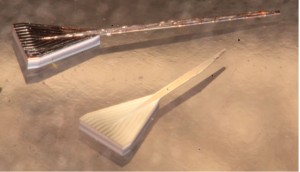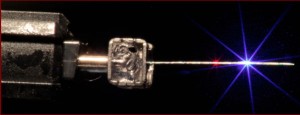Waveguide Micro-probes for Optical Control of Excitable Cells
- Category: Medical Electronics, MEMS & BioMEMS, Optics & Photonics
- Tags: clifton fonstad, ed boyden
Professor Ed Boyden uses light to precisely control neural activity. His lab has invented safe, effective ways to deliver light-gated membrane proteins to neurons and other excitable cells (e.g., muscle, immune cells, pancreatic cells, etc.) in an enduring fashion, thus making the cells permanently sensitive to being activated or silenced by millisecond-timescale pulses of blue and yellow light, respectively [1] . This ability to modulate neural activity with a temporal precision that approaches that of the neural code itself holds great promise for human health, and his lab has developed animal models of epilepsy and Parkinson’s disease to explore the use of optical control to develop new therapies.
We have recently developed mass-fabricatable multiple light guide microstructures produced using standard microfabrication techniques to deliver light to activate and silence neural target regions along their length as desired [2] . Each probe is a 100- to 150-micron-wide insertable micro-structure with many miniature lightguides running in parallel and delivering light to many points along the axis of insertion. Such a design maximizes the flexibility and power of optical neural control while minimizing tissue damage. We are currently developing 2-D arrays of such probes so multiple colors of light can be delivered to 3-dimensional patterns in the brain, at the resolution of tens to hundreds of microns, thus furthering the causal analysis of complex neural circuits and dynamics. Such devices will allow the substrates that causally contribute to neurological and psychiatric disorders to be systematically analyzed via causal neural control tools. Given recent efforts to test such reagents in nonhuman primates, these devices may also enable a new generation of optical neural control prosthetics, contributing directly to the alleviation of intractable brain disorders.
The initial light-guide structures have been fabricated from silicon oxynitride clad with silicon dioxide, and tests show excellent transmission of light with no visible loss in the taper and bend regions of the patterns [2] . Significantly, the novel 90˚ bend invented to direct light laterally out the side of the narrow probe functions as designed [2] . The optical sources for initial tests with the probe are independent laser modules coupled to one end of a fiber-optic ribbon cable (see Figure 2). The other end of the ribbon cable is butt-coupled to the inputs of the probe via a standard fiber-optic connector ferrule. This allows for increased modularity and control in initial probe testing.
We are now utilizing transgenic mice, which express optogenetic activators and silencers in cortical pyramidal neurons, to demonstrate optogenetic control of neural circuits in a fashion appropriate for in vivo circuit mapping or brain machine interface prototyping. Our goal is to explore the degree to which this technology can be used to functionally map neural network connectivity over large, multi-region circuits in the brain, and to subserve a new generation of neural control prosthetics.
- Figure 1: Two free-standing light-guide probes. Each of these probes contains twelve waveguides, each 10 µm by 10 µm in cross-section, running from the input end (where they are spaced 125 µm center-to-center to match a fiber ribbon cable) to a unique 45˚ mirror reflector to direct the light laterally out of the probe.
- Figure 2: A photograph of a light-guide probe (side view) mounted on a coupler ferrule attached to the output of a 12-fiber ribbon cable. Two of the guides on this side of the probe are excited, one with red light and the second with blue light. The emission from the side of the probe is visible in the picture.
- X. Han and E. S. Boyden, “Multiple-color optical activation, silencing, and desynchronization of neural activity, with single-spike temporal resolution,” PLoS ONE, vol. 2, no. 3, p. e299, Mar. 2007. [↩]
- A. N. Zorzos, E. S. Boyden, and C. G. Fonstad, “A multi-waveguide Implantable probe for light delivery to distributed brain targets,” Applied Optics Letters vol. 35, no. 12, pp. 4133-4135, Dec. 2010. [↩] [↩] [↩]

